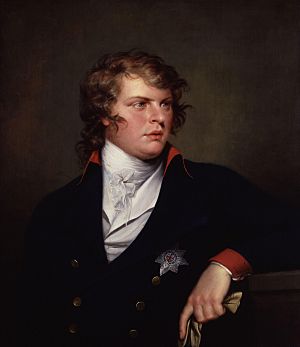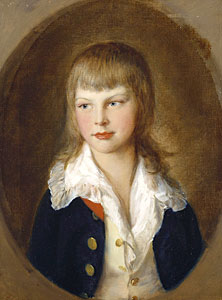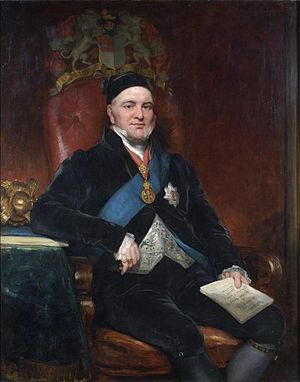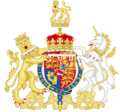Prince Augustus Frederick, Duke of Sussex facts for kids
Quick facts for kids Prince Augustus Frederick |
|
|---|---|
| Duke of Sussex | |

Portrait by Guy Head, 1798
|
|
| Born | 27 January 1773 Buckingham House, London |
| Died | 21 April 1843 (aged 70) Kensington Palace, London |
| Burial | 4 May 1843 Kensal Green Cemetery, London |
| Spouse |
Lady Cecilia Underwood
(m. 1831) |
| Issue | Sir Augustus d'Este Augusta Emma Wilde, Baroness Truro |
| House | Hanover |
| Father | George III, King of the United Kingdom |
| Mother | Charlotte of Mecklenburg-Strelitz |
| 25th President of the Royal Society | |
| In office 1830–1838 |
|
| Preceded by | Davies Gilbert |
| Succeeded by | Spencer Compton |
Prince Augustus Frederick, Duke of Sussex (born January 27, 1773 – died April 21, 1843), was a son of King George III and Queen Charlotte. He was their sixth son and ninth child.
Unlike his brothers, Prince Augustus did not join the army or navy. He was known for his modern and open-minded ideas. He supported important changes like making Parliament fairer, ending the slave trade, and giving more rights to Catholics and Jewish people in Britain.
Contents
About Prince Augustus Frederick
His Early Life
Augustus Frederick was born on January 27, 1773, at Buckingham House in London. He was the ninth child and sixth son of King George III and Queen Charlotte.

He was baptized on February 25, 1773, at St James's Palace. His godparents included important people like the Duke of Saxe-Gotha-Altenburg and Princess Charles of Hesse-Cassel.
Augustus Frederick was taught at home before he went to the University of Göttingen in Germany in 1786. His brothers, Prince Ernest and Prince Adolphus, went with him. Prince Augustus had asthma, so he did not join his brothers in military training. For a short time, he thought about becoming a priest in the Church of England. Later, during the Napoleonic Wars, he served in a volunteer army regiment in Britain.
His First Marriage
While traveling in Italy, Prince Augustus met Lady Augusta Murray (1768–1830). She was the daughter of the 4th Earl of Dunmore. They secretly married in Rome on April 4, 1793. His father, the King, did not know about this marriage.
They married again in London on December 5, 1793, without telling their full identities. Both marriages happened without the King's permission.
In August 1794, a court decided that the prince's first marriage was not allowed. This was because it went against the Royal Marriages Act 1772, which said the King had to approve royal marriages. However, Prince Augustus Frederick and Lady Augusta continued to live together until 1801. Then, he received money from Parliament, and they separated. Lady Augusta kept their two children, Augustus Frederick d'Este and Augusta Emma d'Este. She also received money to support them.
Becoming Duke of Sussex
Prince Augustus Frederick was made a Knight of the Garter on June 2, 1786. The King gave him the titles Duke of Sussex, Earl of Inverness, and Baron Arklow on November 24, 1801. Since he had no children who could legally inherit his titles, these titles ended when he died in 1843.
In 1815, the Duke became a supporter of the Jews' Hospital and Orphan Asylum, which is now a charity called Norwood.
Freemasonry
In January 1813, Prince Augustus Frederick became the Grand Master of the Premier Grand Lodge of England. Later that year, his brother, Prince Edward Augustus, Duke of Kent and Strathearn, became Grand Master of another group, the Antient Grand Lodge of England. On December 27, 1813, these two groups joined together to form the United Grand Lodge of England, with Prince Augustus Frederick as its Grand Master. In 1842, he started the Royal Masonic Benevolent Institution, which helps people.
His Second Marriage

After Lady Augusta D'Ameland passed away, the Duke of Sussex married again on May 2, 1831. This marriage also went against the Royal Marriages Act. He married Lady Cecilia Letitia Buggin (1793–1873). She was the daughter of the 2nd Earl of Arran and the widow of Sir George Buggin. Lady Cecilia was never officially called the Duchess of Sussex. However, Queen Victoria later made her the Duchess of Inverness in 1840.
Later Life and Interests

King William IV gave his younger brother the role of Chief Ranger and Keeper of St James's Park and Hyde Park in 1831. Later, Queen Victoria made her uncle the Governor of Windsor Castle in 1842.
The Duke of Sussex was elected president of the Society of Arts in 1816 and stayed in that role for the rest of his life. He was also the Colonel of the Honourable Artillery Company from 1817. He served as president of the Royal Society between 1830 and 1838. He was very interested in biblical studies and Hebrew. His personal library had over 50,000 religious books and papers, some of them in Hebrew. In 1838, he gave a speech where he talked about how science and religion can work together.
The Duke of Sussex was Queen Victoria's favorite uncle. He walked her down the aisle at her wedding to Prince Albert in 1840.
The Duke of Sussex died at Kensington Palace in 1843, at the age of 70. He asked not to have a big state funeral. He was buried at Kensal Green Cemetery on May 4, 1843. He is buried near his sister, Princess Sophia.
The Duchess of Inverness continued to live at Kensington Palace until she died in 1873. She was buried next to Prince Augustus.
Children
Prince Augustus Frederick had two children with Lady Augusta Murray. He had no children with Lady Cecilia Underwood.
| Name | Birth | Death | Notes |
|---|---|---|---|
| With Lady Augusta Murray (marriage later annulled) | |||
| Augustus Frederick d'Este | 1794 | 1848 | |
| Augusta Emma d'Este | 1801 | 1866 | married Thomas Wilde, 1st Baron Truro; no children. |
| With Lady Cecilia Underwood (married 1831) | |||
| no children | |||
Images for kids
See also
 In Spanish: Augusto de Sussex para niños
In Spanish: Augusto de Sussex para niños


